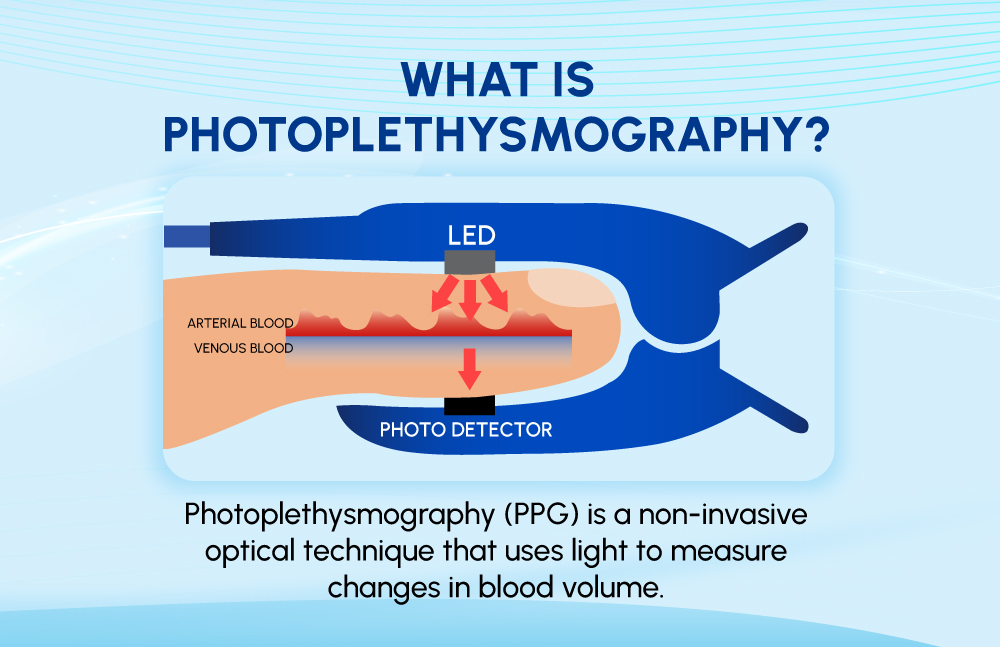
Understanding Photoplethysmography: Components, Types, and Applications
Introduction to Photoplethysmography (PPG)
Photoplethysmography (PPG) is a widely used, non-invasive technology that measures changes in blood volume within the skin’s microvascular bed. By using light-based sensors, PPG detects variations in blood flow, which are closely tied to the rhythmic pumping of the heart.
This technology plays a key role in monitoring important health metrics, such as heart rate, blood oxygen levels, respiratory events, sleep patterns and more. Thus, it is commonly useful in wearable devices like fitness trackers and pulse oximeters.
PPG technology is gaining importance due to its simplicity and low cost. It allows for easy integration into various health monitoring systems, making it an essential tool in modern healthcare. It offers insights into cardiovascular health without the need for complex or invasive procedures.
Device structure
A PPG device consists of two key components: a light source and a photodetector, which work together to measure volumetric changes in blood flow and related parameters.
- Light source
The light source, usually a light-emitting diode (LED), emits light onto the skin. It commonly uses red light (660 nm) and near-infrared light (950 nm) because these wavelengths can penetrate the skin effectively and interact with blood.
Oxyhemoglobin (oxygenated hemoglobin) absorbs more infrared light, while deoxyhemoglobin (deoxygenated hemoglobin) absorbs more red light.
By analyzing how much light is absorbed in these two wavelengths, the device calculates the ratio of oxyhemoglobin to deoxyhemoglobin, which is used to estimate blood oxygen saturation (SpO₂).
- Photodetector
The photodetector captures light that has either passed through or been reflected from the tissue. The amount of light detected changes based on the blood volume in the microvascular bed, which varies with each heartbeat.
The photodetector then converts this detected light into an electrical signal. This signal carries information about blood flow and is processed further to generate readings (heart rate and SpO2).
Types of PPG
There are two types of Photoplethysmography (PPG) used for measuring blood volume changes: Transmission PPG and Reflectance PPG. Both methods use light to detect blood flow, but they differ in how the light interacts with the skin.
- Transmission mode PPG
In the transmission mode of PPG, the light source is placed on one side of the tissue, while the photodetector is positioned on the opposite side to detect the light that passes through.
This method is best suited for areas with thin tissue, such as the fingertip or earlobe. The photodetector captures only the light wavelengths that penetrate the tissue effectively, making it ideal for precise measurements in these locations.
- Reflective mode PPG
In the reflectance mode of PPG, both the light source and the photodetector are placed/positioned on the same side of the tissue. Here, the light source emits light toward the skin, and the photodetector captures the light that is reflected.
This method is particularly useful in areas with thicker tissue, such as the wrist or forehead. This model is an excellent choice for wearable devices and various other applications. Unlike transmission PPG, reflectance PPG is less affected by tissue thickness, providing greater versatility for use on different parts of the body.
How does PPG work?
PPG operates through the following steps:
1. The LED or light source emits light at two specific wavelengths, typically red and infrared.
2. The light penetrates the skin and interacts with the blood in the microvascular bed, where it is either absorbed or reflected.
3. A photodetector captures the light that is transmitted through the tissue or reflected from the skin.
4. The captured light variations are converted into electrical signals by a photosensitive element.
5. These electrical signals are processed and analyzed by a connected application or device.
6. The application or device interprets the processed data and displays metrics such as heart rate and blood oxygen levels derived from the PPG signal.
Uses of PPG
Medical devices based on PPG technology are widely used in various clinical and health monitoring applications such as:
- Measure pulse rate
- Analyze pulse rate variability
- Monitor blood oxygen saturation
- Estimate blood pressure
- Track heart rate
- Assess respiration and breathing events
- Evaluate parasympathetic and sympathetic activity
- Record sleep time and analyze sleep stage
- Diagnose sleep disorders, such as sleep apnea
Conclusion
Photoplethysmography (PPG) is a versatile and non-invasive optical technology that has revolutionized health monitoring. It detects changes in blood volume using light and accurately measures vital parameters such as heart rate, blood oxygen saturation, and even sleep patterns.
Furthermore, its applications in medical devices, wearables (smartwatches), and clinical settings highlight its importance in modern healthcare. With continuous advancements, PPG is poised to play an even greater role in enhancing personal and clinical health management.
Snoreka is an innovative adjustable sleep device that effectively reduces snoring and enhances sleep quality. By gently repositioning your lower jaw, Snoreka helps keep your airways open, ensuring a smoother and quieter sleep.
With the Fastnap Sleep Band, you can easily monitor your sleep quality and diagnose sleep apnea from the comfort of your own home. It is a portable, FDA-approved pulse oximeter designed for accurate, at-home sleep testing, making it a convenient alternative to traditional sleep studies.


